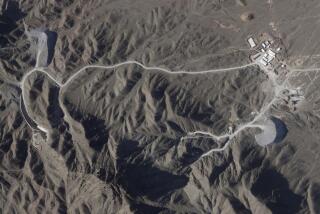Bush’s Dangerous Nuclear Double Standard
President Bush is expected to go to the United Nations today and, with Iran and North Korea obviously in mind, make a strong plea for nuclear nonproliferation.
But the president’s words may ring hollow to much of the world because here at home we’re embarking on a new and dangerous plan to develop and build a new generation of nuclear weapons.
The circumstances are hardly auspicious at a moment when our credibility in the world community is tenuous.
Preventing the proliferation of nuclear weapons is one of the greatest challenges facing the U.S. and the world community today. The Bush administration says it strongly supports that goal.
Yet, in a bill awaiting final action in Congress, the administration is asking for $21 million in appropriations for two new types of nuclear weapons, the so-called mini-nukes and what it calls a “robust nuclear earth penetrator,” the so-called bunker-buster.
The administration also wants funds for the design and site selection of a facility to produce these nuclear warheads and to expedite testing of them.
Pursuing such weapons is a dangerous new direction in U.S. nuclear policy, with ominous implications for the war on terrorism and the delicate balance of international arms control protections.
How can we ask Iran and North Korea to abandon their nuclear programs when we begin to design, build and test new nuclear weapons of our own?
There is nothing “mini” about a mini-nuke. They are far from the type of benign, surgical-strike weapons that the name implies. One of these weapons, carried by a terrorist in a suitcase, could devastate any city in the U.S. The blast from a 5-kiloton nuclear weapon -- the upper threshold of the mini-nukes -- would be half the size of the Hiroshima blast.
The bunker-busters supposedly would be used against deeply buried, hardened targets. Current technology will allow a warhead to burrow up to 50 feet into the ground. But detonating even a 1-kiloton nuclear weapon at that depth would produce a crater larger than a football field and spew a million cubic feet of radioactive dust and debris into the atmosphere.
The requests to expedite the ability to test and produce these new weapons leaves no doubt about the administration’s strategy. Basically, it wants to have these weapons available in our arsenal and ready to use as soon as possible.
The White House is asking for a large-scale facility capable of producing up to 500 of these warheads a year.
That level far exceeds what would be needed to maintain our current stockpile of weapons in coming years, especially when we have pledged to reduce our stockpile by more than half in arms control agreements.
The administration’s new direction on nuclear weapons has received far too little attention in policy debates. It threatens to undermine the entire architecture of nuclear arms control that has been put in place with great difficulty over the last half a century.
We know the real dangers we face in the world today. It is wrong to add another one by treating nuclear weapons as just another weapon in the arsenal.
It makes no sense to adopt a policy that makes their use more likely.
More to Read
Sign up for Essential California
The most important California stories and recommendations in your inbox every morning.
You may occasionally receive promotional content from the Los Angeles Times.










